1997 BUICK CENTURY maintenance schedule
[x] Cancel search: maintenance schedulePage 283 of 406
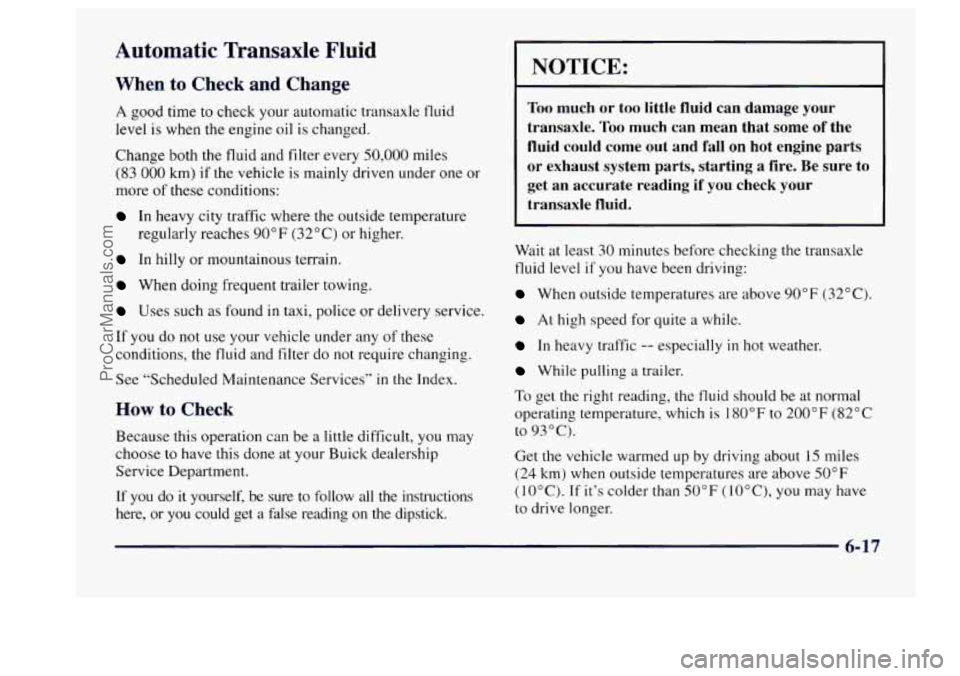
Automatic Transaxle Fluid
When to Check and Change
A good time to check your automatic transaxle fluid
level
is when the engine oil is changed.
Change both the fluid and filter every
50,000 miles
(83
000 km) if the vehicle is mainly driven under one or
more of these conditions:
In heavy city traffic where the outside temperature
regularly reaches
90°F (32°C) or higher.
In hilly or mountainous terrain.
When doing frequent trailer towing.
Uses such as found in taxi, police or delivery service.
If you do not use your vehicle under any
of these
conditions, the fluid and filter do not require changing.
See "Scheduled Maintenance Services"
in the Index.
How to Check
Because this operation can be a little difficult, you may
choose
to have this done at your Buick dealership
Service Department.
If you do it yourself, be sure to follow all the instructions
here, or you could get a false reading on
the dipstick.
NOTICE:
Too much or too little fluid can damage your
transaxle.
Too much can mean that some of the
fluid could come out and fall on
hot engine parts
or exhaust system parts, starting a fire. Be sure to get an accurate reading if you check your
transaxle fluid.
Wait at least 30 minutes before checking the transaxle
fluid level
if you have been driving:
When outside temperatures are above 90°F (32°C).
At high speed for quite a while.
In heavy traffic -- especially in hot weather.
While pulling a trailer.
To get the right reading, the fluid should be at normal
operating temperature, which
is 180°F to 200°F (82°C
to 93 " C).
Get the vehicle warmed up by driving about
15 miles
(24 km) when outside temperatures are above 50°F
(10°C). If it's colder than 50°F (lO"C), you may have
to drive longer.
6-17
ProCarManuals.com
Page 285 of 406
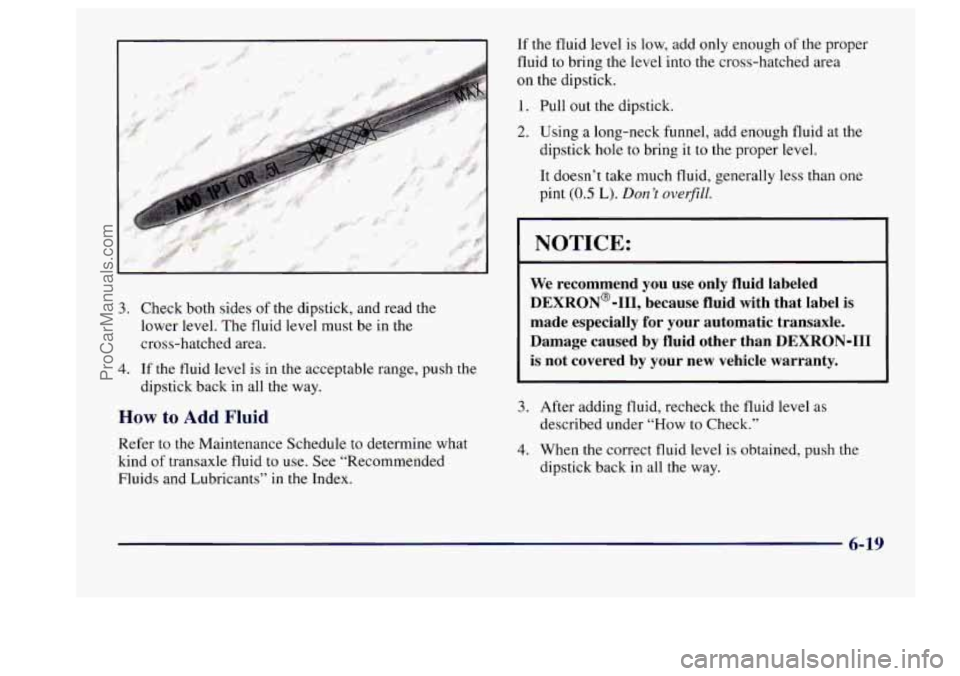
3. Check both sides of the dipstick, and read the
lower level. The fluid
level must be in the
cross-hatched area.
4. If the fluid level is in the acceptable range, push the
dipstick back
in all the way.
How to Add Fluid
Refer to the Maintenance Schedule to determine what
kind
of transaxle fluid to use. See “Recommended
Fluids and Lubricants”
in the Index. If
the fluid level is low, add only enough
of the proper
fluid to bring the level into the cross-hatched area
on the dipstick.
1. Pull out the dipstick.
2. Using a long-neck funnel, add enough fluid at the
dipstick hole to bring it to the proper
level.
It doesn’t take much fluid, generally less than one
pint
(0.5 L). Dun ’t overfill.
I NOTICE: I
We recommend you use only fluid labeled
DEXRON@-111, because fluid with that label
is
made especially for your automatic transaxle.
Damage caused by fluid other than DEXRON-I11
is not covered by your new vehicle warranty.
3. After adding fluid, recheck the fluid level as
described under
“How to Check.”
4. When the correct fluid level is obtained, push the
dipstick back in all the way.
6-19
ProCarManuals.com
Page 305 of 406

Tire Inspection and Rotation
Tires should be rotated every 6,000 to 8,000 miles
(10 O00 to 13 OOO km). Any time you notice unusual wear,
rotate your tires as soon as possible and check wheel
alignment.
Also check for damaged tires or wheels.
See “When It’s Time for New Tires” and ‘Wheel
Replacement” later
in this section for more information.
The purpose of regular rotation is to achieve more
uniform wear for all tires on the vehicle. The first
rotation is the most important. See “Scheduled
Maintenance Services” in the Index for scheduled
rotation intervals. Don’t include the compact spare tire
in your tire rotation.
After the tires have been rotated, adjust the front and
rear inflation pressures as shown
on the Tire-Loading
Information label. Make certain that all wheel nuts
are properly tightened. See “Wheel Nut Torque”
in the Index.
Rust or dirt on a wheel, or on the parts to which
it is fastened, can make wheel nuts become loose
after a time. The wheel could come
off and cause
an accident. When you change a wheel, remove
any rust or dirt from places where the wheel
attaches to the vehicle. In an emergency, you can
use a cloth or a paper towel to do this; but be
sure to use
a scraper or wire brush later, if you
need to, to get all the rust or dirt off. (See
“Changing
a Flat Tire” in the Index.)
When rotating your tires, always use the correct rotation
pattern shown here.
.. ~ 6-39
ProCarManuals.com
Page 331 of 406
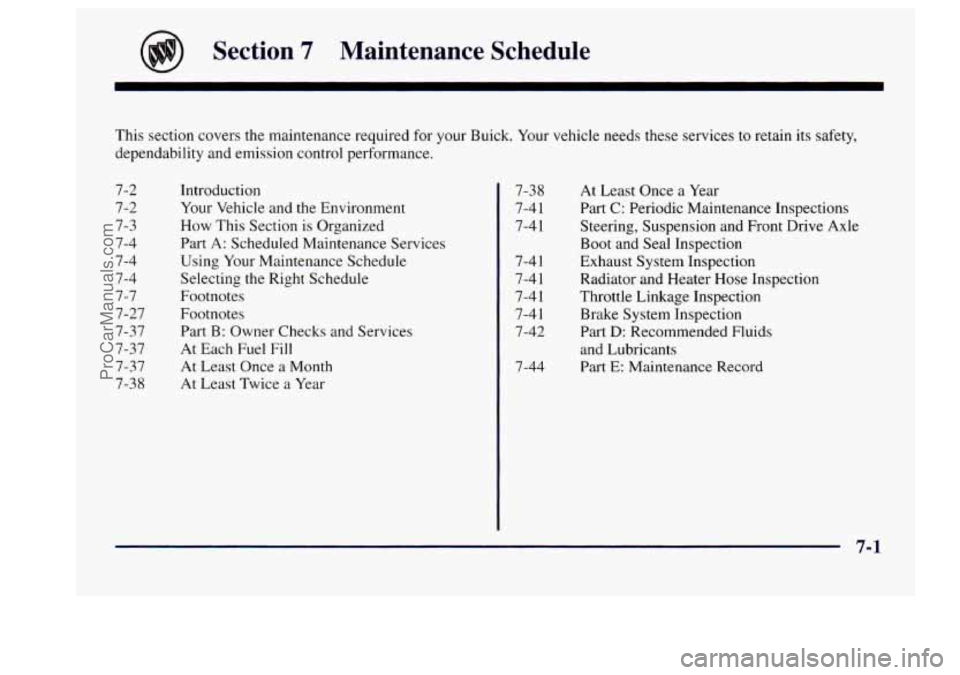
Section 7 Maintenance Schedule
This section covers the maintenance required for your Buick. Your vehicle needs these services to retain its safety,
dependability and emission control performance.
7-2
7-2
7-3 7-4
7-4
7-4
7-7
7-27
7-37
7-37
7-37
7-38 Introduction
Your Vehicle and the Environment
How This Section is Organized
Part
A: Scheduled Maintenance Services
Using Your Maintenance Schedule
Selecting the Right Schedule
Footnotes
Footnotes
Part
B: Owner Checks and Services
At Each
Fuel Fill
At Least Once a Month
At Least Twice
a Year At
Least Once a Year
Part
C: Periodic Maintenance Inspections
Steering, Suspension and Front Drive Axle
Boot and Seal Inspection
Exhaust System Inspection
Radiator and Heater Hose Inspection
Throttle Linkage Inspection
Brake System Inspection
Part
D: Recommended Fluids
and Lubricants
Part
E: Maintenance Record
7-38
7-4 I
7-4 1
7-4 1
7-4 1
7-4 1
7-4 1
7-42
7 -44
7-1
ProCarManuals.com
Page 333 of 406
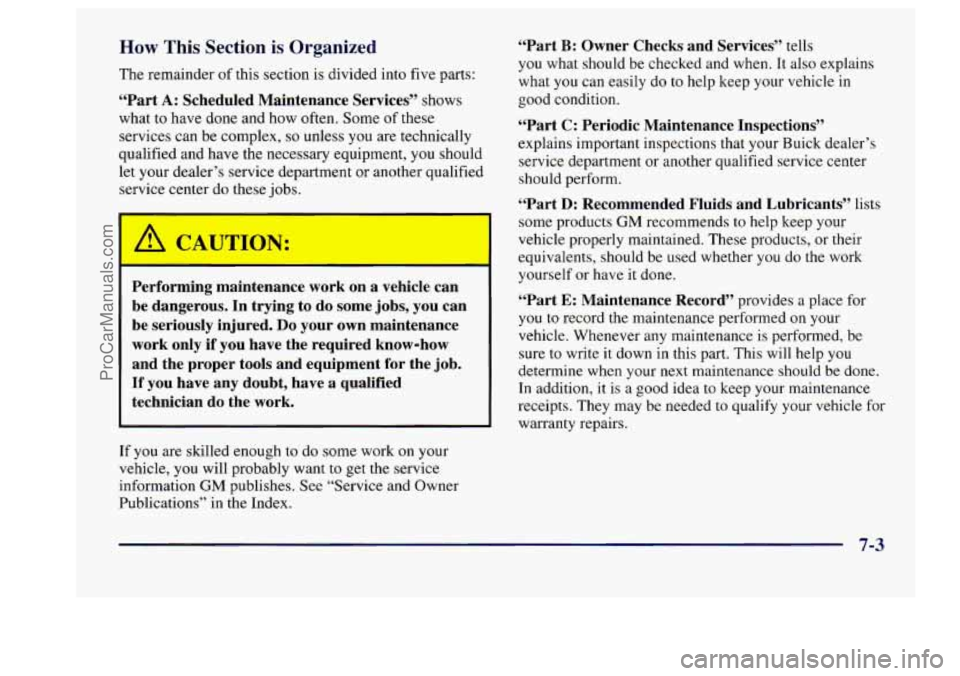
How This Section is Organized
The remainder of this section is divided into five parts:
“Part A: Scheduled Maintenance Services’’ shows
what
to have done and how often. Some of these
services can be complex,
so unless you are technically
qualified and have the necessary equipment, you should
let your dealer’s service department or another qualified
service center do these jobs.
I A CAUTION: I
Performing maintenance work on a vehicle can
be dangerous. In trying to
do some jobs, you can
be seriously injured.
Do your own maintenance
work only if
you have the required know-how
and the proper tools and equipment for the job.
If you have any doubt, have a qualified
technician do the work.
If you are skilled enough to do some work on your
vehicle, you will probably want
to get the service
information
GM publishes. See “Service and Owner
Publications” in the Index.
“Part B: Owner Checks and Services” tells
you what should be checked and when. It also explains
what
you can easily do to help keep your vehicle in
good condition.
“Part C: Periodic Maintenance Inspections”
explains important inspections that your Buick dealer’s
service department or another qualified service center
should perform.
“Part D: Recommended Fluids and Lubricants” lists
some products
GM recommends to help keep your
vehicle properly maintained. These products, or their
equivalents, should be used whether you
do the work
yourself or have it done.
“Part E: Maintenance Record” provides a place for
you to record the maintenance performed
on your
vehicle. Whenever any maintenance is performed,
be
sure to write it down in this part. This will help you
determine when your next maintenance should be done.
In addition, it is a good idea to keep your maintenance
receipts. They may be needed
to qualify your vehicle for
warranty repairs.
7-3
ProCarManuals.com
Page 334 of 406
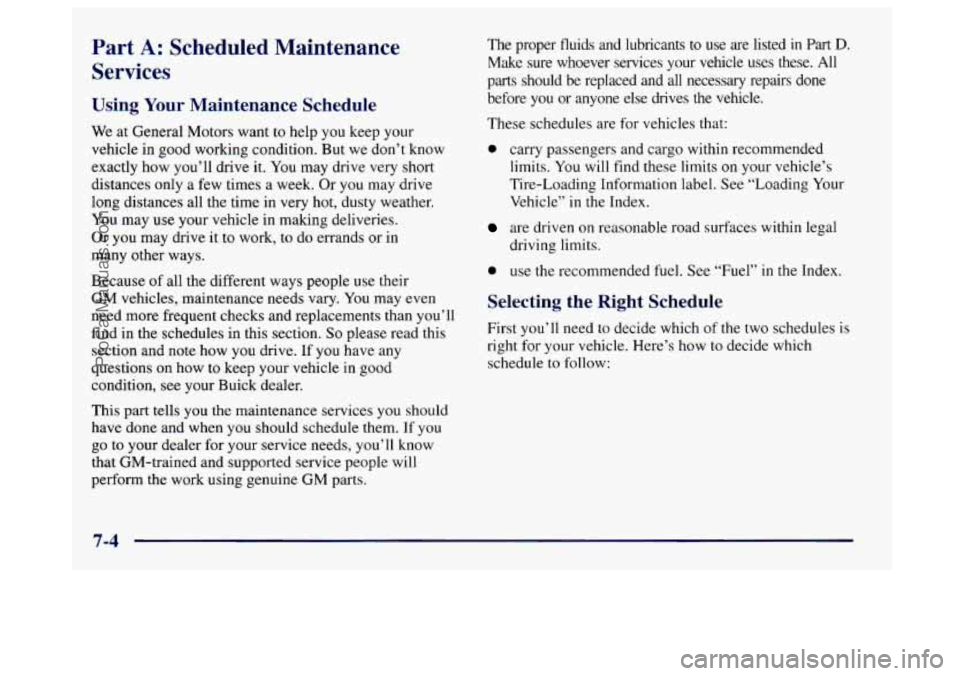
Part A: Scheduled Maintenance
Services
Using Your Maintenance Schedule
We at General Motors want to help you keep your
vehicle in good working condition. But we don’t know
exactly how you’ll drive it. You may drive
very short
distances only a few times a week. Or you may drive
long distances all the time in very hot, dusty weather.
You may
use your vehicle in making deliveries.
Or you may drive it to work, to
do errands or in
many other ways.
Because
of all the different ways people use their
GM vehicles, maintenance needs vary. You may even
need more frequent checks and replacements than you’ll
find in the schedules in this section.
So please read this
section and note
how you drive. If you have any
questions on how to keep your vehicle in good
condition,
see your Buick dealer.
This part tells
you the maintenance services you should
have done and when you should schedule them. If you
go
to your dealer for your service needs, you’ll know
that GM-trained and supported service people will
perform the work using genuine
GM parts. The proper fluids and lubricants to use are listed
in Part D.
Make sure whoever services your vehicle uses these. All
parts should be replaced and all necessary repairs done
before you or anyone else drives the vehicle.
These schedules are for vehicles that:
0 carry passengers and cargo within recommended
limits. You will find these limits
on your vehicle’s
Tire-Loading Information label. See “Loading Your
Vehicle”
in the Index.
are driven on reasonable road surfaces within legal
driving limits.
0 use the recommended fuel. See “Fuel” in the Index.
Selecting the Right Schedule
First you’ll need to decide which of the two schedules is
right for your vehicle. Here’s how to decide which
schedule
to follow:
7-4
ProCarManuals.com
Page 335 of 406
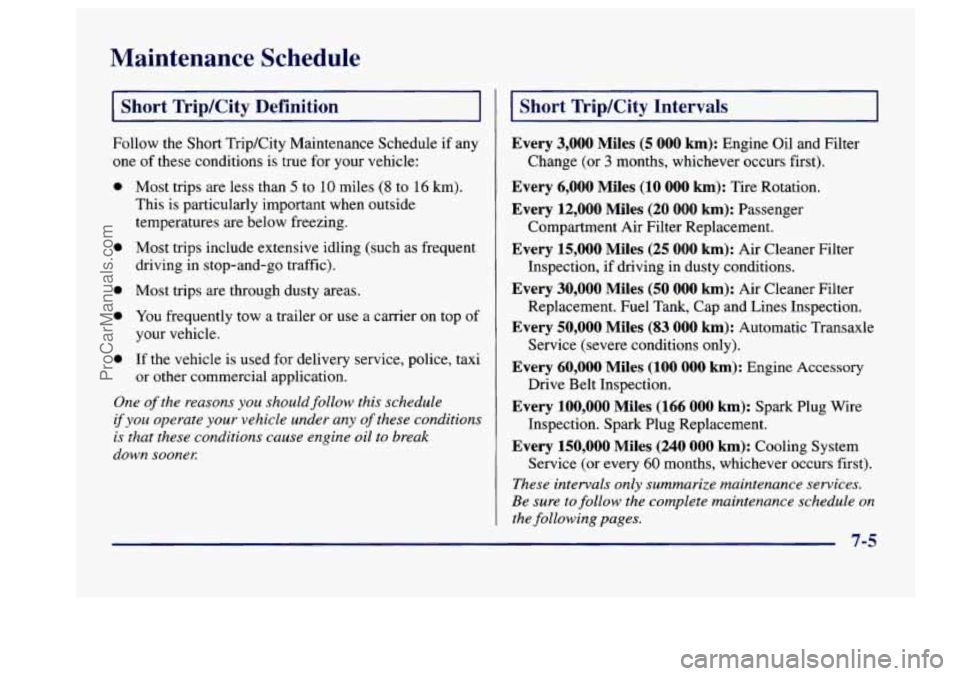
Maintenance Schedule
Short TripKity Definition
Follow the Short Trip/City Maintenance Schedule if any
one of these conditions is true for your vehicle:
0
a
0
a
a
Most trips are less than 5 to 10 miles (8 to 16 km).
This is particularly important when outside
temperatures are below freezing.
Most trips include extensive idling (such as frequent
driving in stop-and-go traffic).
Most trips are through dusty areas.
You frequently tow a trailer or use a carrier on top of
your vehicle.
If the vehicle is used for delivery service, police, taxi
or other commercial application.
One of the reasons you should follow this schedule
if you operate your vehicle under any of these conditions
is that these conditions cause engine oil to break
down sooney.
Short Trip/City Intervals
Every 3,000 Miles (5 000 km): Engine Oil and Filter
Change
(or 3 months, whichever occurs first).
Every 6,000 Miles (10 000 km): Tire Rotation.
Every 12,000 Miles (20 000 Jan): Passenger
Compartment Air Filter Replacement.
Every 15,000 Miles (25 000 km): Air Cleaner Filter
Inspection,
if driving in dusty conditions.
Every 30,000 Miles (50 000 km): Air Cleaner Filter
Replacement. Fuel Tank, Cap and Lines Inspection.
Every 50,000 Miles (83 000 km): Automatic Transaxle
Service (severe conditions only).
Every 60,000 Miles (100 000 km): Engine Accessory
Drive Belt Inspection.
Every 100,000 Miles (166 000 km): Spark Plug Wire
Inspection. Spark Plug Replacement.
Every 150,000 Miles (240 000 km): Cooling System
Service (or every
60 months, whichever occurs first).
These intervals only summarize maintenance services.
Be sure
to follow the complete maintenance schedule on
the following pages.
II -7 -5
ProCarManuals.com
Page 336 of 406
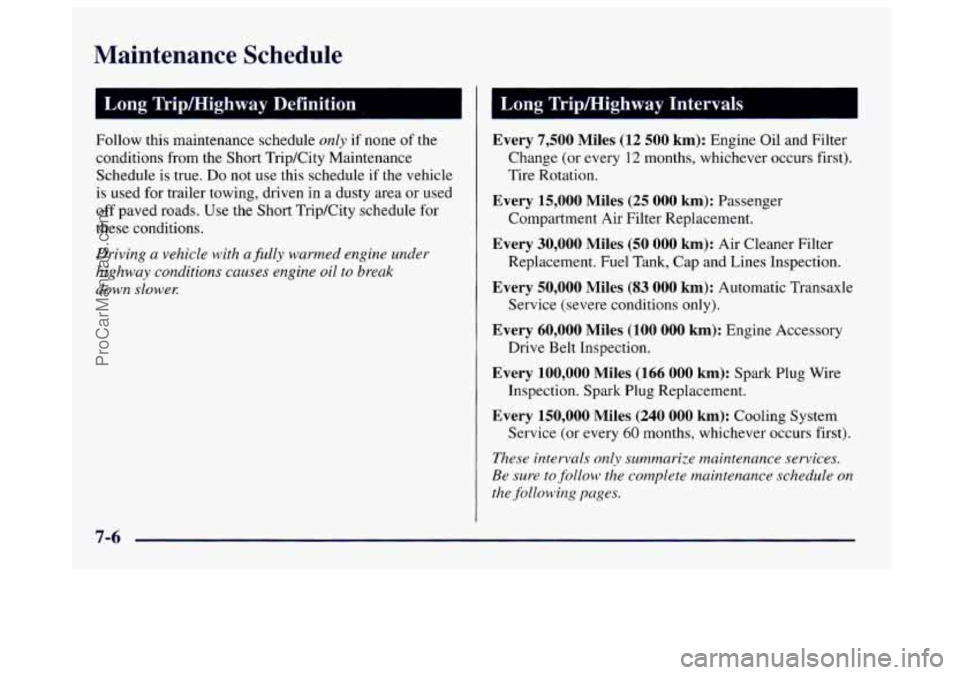
Maintenance Schedule
1 Long Tripmighway Definition
Follow this maintenance schedule only if none of the
conditions from the Short TripKity Maintenance
Schedule is true. Do not use this schedule if the vehicle
is used for trailer towing, driven in a dusty area or used
off paved roads. Use the Short TripKity schedule for
these conditions.
Driving a vehicle with a fully warmed engine under
highway conditions causes engine oil to break
down slowel:
I Long Tripmighway Intervals
Every 7,500 Miles (12 500 km): Engine Oil and Filter
Change (or every
12 months, whichever occurs first).
Tire Rotation.
Every 15,000 Miles (25 000 km): Passenger
Compartment Air Filter Replacement.
Every 30,000 Miles (50 000 km): Air Cleaner Filter
Replacement. Fuel Tank, Cap and Lines Inspection.
Every 50,000 Miles (83 000 km): Automatic Transaxle
Service (severe conditions only).
Every 60,000 Miles (100 000 km): Engine Accessory
Every 100,000 Miles (166 000 km): Spark Plug Wire
Every 150,000 Miles (240 000 km): Cooling System
Drive Belt Inspection.
Inspection. Spark Plug Replacement. Service (or every
60 months, whichever occurs first).
These intervals only summarize maintenance services.
Be sure to,follow the complete maintenance schedule on
the.following pages.
7-6
ProCarManuals.com